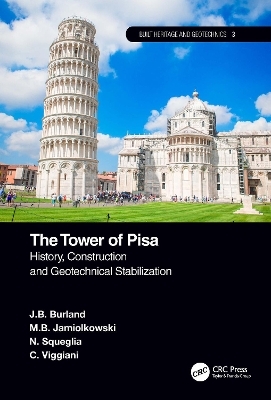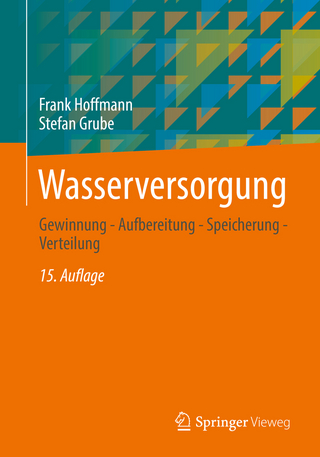
The Tower of Pisa
CRC Press (Verlag)
978-0-367-49428-5 (ISBN)
- Titel z.Zt. nicht lieferbar
- Versandkostenfrei innerhalb Deutschlands
- Auch auf Rechnung
- Verfügbarkeit in der Filiale vor Ort prüfen
- Artikel merken
The Leaning Tower of Pisa is known worldwide for its five-degree lean. The Tower is the Campanile of the Cathedral, which together with the Baptistry and Cemetery form a breath-taking collection of monuments which are regarded as supreme examples of early Renaissance Romanesque architecture. In March 1990 the Tower was closed to the public as it was declared unsafe and close to collapse. A Commission was set up by the Italian Government with the task of developing and implementing stabilization measures.
This book begins with a brief description of the history of the Tower and its construction. The reader is then introduced to the huge challenges faced by the Commission in designing and implementing appropriate stabilization measures whilst at the same time satisfying the demanding requirements of conserving a world heritage monument. In particular, two historical studies are described which proved to be most valuable in arriving at suitable stabilization measures. The first was a deduction of the history of inclination of the tower during and subsequent to construction. The results of this study were used to calibrate a sophisticated numerical model of the tower and the underlying very soft ground which proved vital in evaluating the effectiveness of various stabilization schemes. The second study was of measurements of movement made since 1911. This latter study revealed an unexpected mechanism of foundation movement which proved crucial in developing the temporary and permanent stabilization measures and which resulted in the Tower being re-opened to the public in June 2001.
The book will appeal to both professionals and students in the fields of Architecture and Civil Engineering. It will also interest specialised audiences of geotechnical engineers and conservation architects. It may also be of wider interest to anyone planning to visit Pisa or who is intrigued as to what caused the Tower to lean and how it was stabilized.
Born in the UK, Professor John Burland was educated in South Africa and studied Civil Engineering at the University of the Witwatersrand. He returned to England in 1961, worked with Arup for two years and obtained the PhD degree from Cambridge University in 1966. He then joined the Building Research Station becoming Head of the Geotechnics Division in 1972 and Assistant Director in 1979. In 1980 he was appointed to the Chair of Soil Mechanics at Imperial College London where he is now Emeritus Professor and Senior Research Investigator. Specialising in problems relating to the interaction between the ground and masonry buildings he was a member of the international board of consultants advising on the stabilisation of the Metropolitan Cathedral of Mexico City and was a member of the Italian Prime Minister’s Commission for stabilising the Leaning Tower of Pisa. He has received many awards and medals including the Kelvin Gold Medal for outstanding contributions to Engineering and the Gold Medals of the Institution of Structural Engineers and of the Institution of Civil Engineers. He is a Fellow of both the Royal Academy of Engineering and of the Royal Society and was appointed Commander of the British Empire in 2005. Michele Jamiolkowski is Emeritus Professor of Geotechnical Engineering at the Technical University of Torino. He is founder and Chairman of the Engineering Consultant Company, Studio Geotecnico Italiano. He has been President of the International Society for Soil Mechanics and Geotechnical Engineering, Chairman of the International Committee for Safeguard of the Leaning Tower of Pisa. He presently is Chairman of the International Board of Experts for the Development of the Second World Largest Copper Mine Tailings Depository in Zelazny Most, Poland. Among many awards and honours he is Foreign Associate of the US National Academy of Engineering and Honorary International Member of the Japanese Geotechnical Society. Over his long career Michele Jamiolkowski has been invited to present many general reports at International Conferences and to deliver many significant lectures throughout the world, including the James Forrest Lecture to the ICE in London, the Terzaghi Oration and the Rankine Lecture. Michele Jamiolkowski is author and co-author of more than 270 publications. Nunziante Squeglia is Assistant Professor of Geotechnics and Foundation Engineering at University of Pisa, Italy. He is author of research papers focused on experimental soil behavior, soil-structure interaction, pile foundation, levee stability and preservation of monuments. Since 1992 he has been involved in studies related to stabilization of Pisa Tower, starting from the field experiment on electroosmotic consolidation of Pancone clay. He has been involved in preservation actions on San Piero a Grado and San Paolo a Ripa d’Arno churches (Tuscany, Italy). Since 1998 he is in charge of monitoring of the Tower and he is currently assistant member of the panel appointed to monitor the behaviour of the tower. Carlo Viggiani is Emeritus Professor of Foundation Engineering at University of Napoli Federico II, Italy. He is author of research papers primarily focused on experimental soil behaviour, soil-structure interaction, pile foundation and preservation of monuments. He is co-author of a book on Piles and Pile Foundations published in 2012 by Taylor and Francis / CRC Press. Carlo has been President of the Technical Committee 301 (Preservation of Monuments and Historic Sites) of the ISSMGE (International Society of Soil Mechanics and Geotechnical Engineering) and is now member of the same TC, appointed by the Italian Geotechnical Association. He has been involved in preservation actions on a number of monuments and historic sites and has been member of the Technical Committee in charge of the stabilization of the Pisa Tower, and is currently member of the panel appointed to monitor the behaviour of the tower.
1. Introduction. 2. The Leaning Tower. 3. The subsoil of the Tower. 4. History of the construction and inclination. 5. The results of monitoring: 1911-1990. 6. Studies and undertakings in the 20th century. 7. Leaning instability. 8. The work of the International Committee, 1990-2001. 9. And now? 10. Concluding remarks
| Erscheinungsdatum | 17.07.2023 |
|---|---|
| Reihe/Serie | Built Heritage and Geotechnics |
| Zusatzinfo | 22 Illustrations, color |
| Verlagsort | London |
| Sprache | englisch |
| Maße | 174 x 246 mm |
| Gewicht | 120 g |
| Themenwelt | Geisteswissenschaften ► Archäologie |
| Naturwissenschaften ► Biologie ► Ökologie / Naturschutz | |
| Technik ► Architektur | |
| Technik ► Bauwesen | |
| Technik ► Umwelttechnik / Biotechnologie | |
| ISBN-10 | 0-367-49428-0 / 0367494280 |
| ISBN-13 | 978-0-367-49428-5 / 9780367494285 |
| Zustand | Neuware |
| Informationen gemäß Produktsicherheitsverordnung (GPSR) | |
| Haben Sie eine Frage zum Produkt? |
aus dem Bereich


